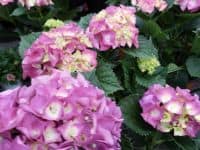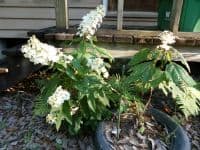
Hydrangeas
Hydrangea macrophylla is divided into two types, Hortensia which are the big flower clusters and Lacecaps which have a center of fertile non-showy flowers encircled by showy non-fertile flowers. Hydrangea macrophylla also known as the common hydrangea, mophead, French Hydrangea or Hortensia is a deciduous shrub which can reach 5 feet x 4 feet. Known for showy summer flowers they make excellent cut and dry flowers arrangements. Blooms come in colors from white, clear pink to dark blue with shades in between. Best planted from November to February. This plant flowers more in partial sun. Supply organic, loose, well drained soil, plenty of moisture and mulch. Fertilize in February with an all purpose plant food. Acidic soils cause it to produce blue flowers and acidic soils make pinkish flowers. Apply 1/4 cup of aluminum sulfate several times around the roots of plants to change pink flowers to blue. Lime may be added in small increments to create pink flowers and may take a couple of years for the change to occur.


Hydrangea quercifolia or oakleaf hydrangea is a native deciduous shrub. This shrub can mature to 8 feet x 5 feet. It has white flowers only which are elongated. The leaves look like oak leaves and have color in autumn with peeling bark which make this plant attractive. Plant in partial shade November to March as it grows well in sandy loam soil, moist mounded soil. I find Oakleaf hydrangea prefers less water than Macrophylla. Fertilize the same as the garden hydrangeas. Flowers should be pruned after blooming to encourage growth and to ensure blooms for next season.
submitted by Karen Blackburn
